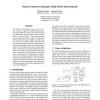21 search results - page 4 / 5 » Dispersion behaviors for a team of multiple miniature robots |
ICRA
2003
IEEE
13 years 10 months ago
2003
IEEE
— Multiple, independent robot platforms promise significant advantage with respect to robustness and flexibility. However, coordination between otherwise independent robots req...
ATAL
2006
Springer
13 years 8 months ago
2006
Springer
A novel control mechanism was recently introduced based on Extended Markov Tracking (EMT) [9, 10]. In this paper, we present a study of its response to multiple interacting contro...
ROBOCUP
1999
Springer
13 years 9 months ago
1999
Springer
All mobile robots require some form of motion control in order to exhibit interesting autonomous behaviors. This is even more essential for multi-robot, highly-dynamic environment...
ROBOCUP
2001
Springer
13 years 9 months ago
2001
Springer
Abstract. Robot soccer is a challenging research domain, which involves multiple agents (physical robots or ”softbots”) to work together in a dynamic, noisy, cooperative and ad...
ROBOCUP
2004
Springer
13 years 10 months ago
2004
Springer
The paper discusses a top-down approach to model soccer knowledge, as it can be found in soccer theory books. The goal is to model soccer strategies and tactics in a way that they ...

